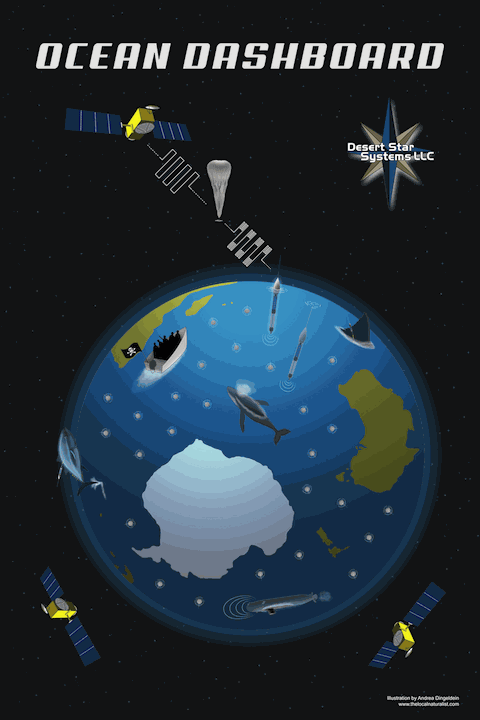Ocean Dashboard
A self-sustaining, persistent-mesh network, easily deployable from the air to monitor the oceans acoustically.

The oceans are among the most important resources of our planet. And while ocean technology is very sophisticated, traditional high-cost products, architectures and business models have resulted in low sensor densities. Low sensor densities have left much of what happens in the ocean invisible or uncertain.
At Desert Star, we hear about the consequences of that lack of visibility most every day. The state of some fisheries is poorly known; the risk of a crash clearly present. Navies are struggling to control fishermen turned pirate by the depletion of their resource; as illegal industrial fishing vessels 'go dark' and escape detection. Whales get entangled in growing obstacle courses of pot fishery gear. And, while extraordinary large biomasses have been discovered in the mesopelagic zone, their importance in the ocean food web and function as a carbon sink is poorly understood.
But how could a revolution in ocean sensing be initiated? Twenty-five years ago our young company realized that the key to reducing ocean technology costs dramatically lay in building a broad product line of sensors and systems on the foundation of a single but modular architecture. While demand for any individual sensor type might be moderate, the engineering designs and manufacturing components could be re-arranged and used over and over again, dramatically building economies of scale. Executing on this philosophy, our small company offers a remarkably broad ocean tech product line including satellite reporting tags, acoustic releases, underwater positioning systems, tracking ranges, modems and sound localization capable underwater recorders.
We have introduced products that not only push innovation but are often available at a fraction of comparable devices. For example, our pop-up satellite tags for fish research have now reached a $499 price point, down from competitor's $4000. In response, study sample sizes are going up and the products are enabling new applications, markets, and users for whom costs were previously prohibitive or technical capabilities inadequate.. For example, our acoustic releases, a technology previously in the domain of science and large offshore projects, are now improving the business of pot fishermen while reducing the hazard to whales.
This is but a small beginning. Proof of our business concept, and a starting point towards an 'ocean dashboard' that can monitor and interact with our ocean resource in myriad interlinked ways. At the core of such a dashboard will be a small, mass-produced and near the universally applicable communicating sens
Just a few decades ago, microcontrollers, sensors, and embedded systems were rare and expensive; or knowledge of everything from the global weather to moisture levels on a particular farmer's field spotty and uncertain. Yet today, it is hard to imagine our world and its responsible management without the myriad of sensors and communicating devices that surround us, monitor our activities, protects our resources and allows us to interact and understand our world in critical detail. While predicting a future ultimately driven by millions of cheap smart sensors deployed from ships or planes in bulk, observing, reporting and ultimately recovered and recycled may appear as a leap of faith now, surely the time will come when the sparse monitoring and poor understanding of this most critical resource today will come to be seen as a reckless and archaic state of affairs. Indeed, our thinking is not isolated. While unique in visualizing very high sensor densities at very low cost and size, it is fundamentally reflected in the thinking of other pioneers such as Liquid Robotics with their concept of the Digital Ocean, or Boeing's recognition of that need as demonstrated by their acquisition of Liquid Robotics and its wave glider.
In time this vision will come to pass, but we also realize that Desert Star is an organization far too small and limited to execute on such a globe-spanning scale: Beyond the sensors at sea, implementation of the Ocean Dashboard will require a robust ocean data relay infrastructu
What could a WD-1 sensor do? This picture sequence shows a SeaTag-MOD first tagged on a tiger shark in late 2011 in the Bahamas (Neil Hammerschlag, RSMAS, U Miami). The tag tracked the shark's migration to Bermuda, New England and back for a year, studying its behavior
. It separated in late 2012, then drifted across the Atlantic for two years (center picture). Arriving in the seas west of Ireland, its data indicated unusual activity. It had 'discovered' the methane seeps of the large and important Porcupine gas field. SeaTag-MOD was designed for the narrow purpose of animal migration tracking, but this episode indicates the capabilities and widespread potential of these tiny autonomous ocean explorers and observers. WD-1 will build on SeaTag-MOD, adding a sound localizing acoustic detector and recorder, a buoyancy engine and more sensor options to arrive at a mass-production device with a universality for ocean sensing not unlike that of the smartphone.
The Evolution to the WD-1 Sensor
Technology Readiness
Product - WD-1 Sensor (Ocean Dashboard) 
Readiness Rating - Development
Priority Level - Low
Sales Rating - Unavailable








